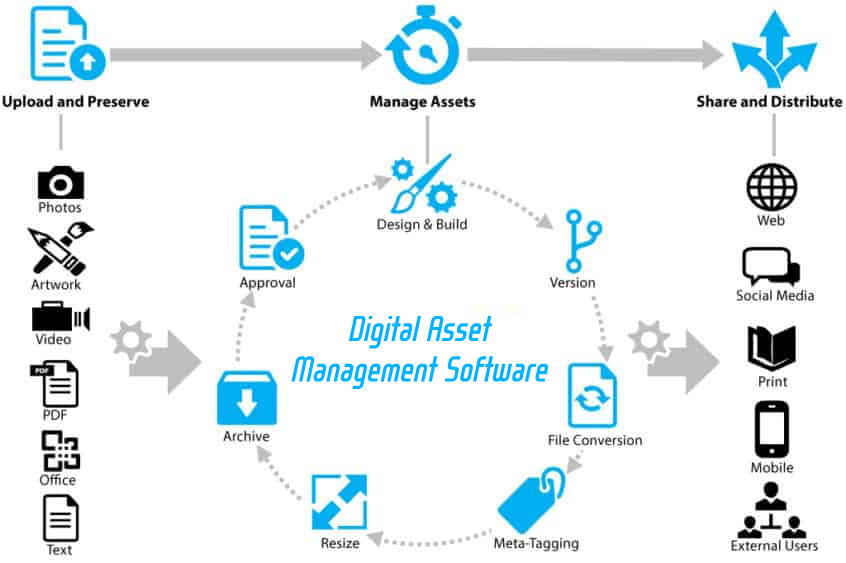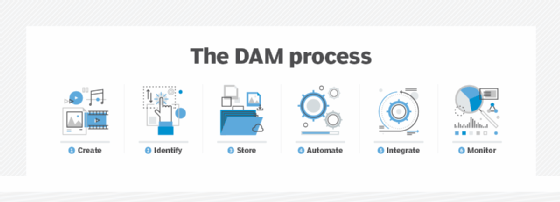
Digital Asset Management (DAM) software represents a technological solution tailored to assist enterprises in the efficient storage, arrangement, administration, and dissemination of digital assets. These digital assets encompass images, videos, documents, audio files, creative designs, marketing materials, and various media files. DAM software offers significant utility to businesses, marketing units, creative agencies, and any entity grappling with substantial volumes of digital content.
- What is Digital Asset Management Software ?

Digital Asset Management (DAM) denotes specialized software harnessed by corporations for the efficient storage, administration, retrieval, and distribution of digital files. These systems empower employees and both internal and external associates to reach an expansive digital resource repository encompassing images, videos, presentations, and documents. By simplifying the organization and retrieval of these digital assets, DAM platforms augment team efficiency and grant businesses the ability to tactically leverage their digital content in pursuit of their goals.
2. What are the Benefits of DAM software?

An effective digital asset management system transcends its role as a simple storage repository for digital assets. It offers improved transparency and operates as a unified, trustworthy wellspring for creative experts, marketers, brand overseers, CMOs, and additional contributors. This centralized focal point assumes a pivotal role in effectively pursuing your corporate objectives.
- Support Video Marketing: Handling video files, frequently characterized by their considerable size and diverse formats, can be an intimidating task. Enterprise DAM systems that encompass video capabilities streamline the generation of video adaptations on a substantial scale. This guarantees the appropriate video version is dispensed to the intended audience, irrespective of their display device, internet speed, or operating system. This refinement contributes to the efficacy of marketing initiatives focused on video content.
- Empower Local Sales Initiatives: Facilitating the customization of content by local sales teams to suit their particular markets holds significant importance. An enterprise DAM equipped with distributed marketing functionalities supplies local teams with modifiable campaign kits and assortments of media. This guarantees uniformity in brand representation, adherence to legal standards, and the facilitation of prompt local content creation, thereby amplifying agility at the grassroots level.
- Measure ROI and Asset Performance: Crafting adaptable utilization reports and monitoring asset activations stands as a fundamental element in making well-informed decisions. DAM systems empower companies to gauge and compile data regarding the utilization and effectiveness of digital assets across various platforms. This centralized information imparts valuable perspectives on product classifications, regional influence, and demographic sectors.
- Automate Repetitive Tasks and Consolidate Tools: DAM systems amalgamate redundant utilities and mechanize recurrent activities, thus simplifying operational procedures and enabling teams to dedicate their efforts to core responsibilities. Through the automation of mundane processes, these systems boost efficiency, granting companies the capacity to expand and bolster their brand successfully.
- Enhance Brand Consistency: Preserving a consistent brand image across a wide array of platforms is of utmost importance for businesses, a task that often places a substantial burden on the marketing team in terms of time and effort. Fortunately, contemporary DAM systems like Open Asset streamline this endeavor by offering a centralized hub for the management and retrieval of media assets, guaranteeing consistency in how the brand is presented.
- Improve Collaboration: Conventional approaches, such as using email for the exchange of files, have become outdated, particularly when managing substantial quantities of digital assets. Digital asset management systems promote both internal and external collaboration without necessitating extra software. This encourages productive teamwork and trims the time required to launch vital campaigns.
- Ensure Legal Compliance: Companies, spanning from global brands to architectural enterprises, frequently encounter challenges related to regulatory compliance, particularly in regard to logos and licensed assets. Digital asset management systems aid in monitoring the utilization of licensed photos and images, thereby reducing legal liabilities and ensuring adherence to usage rights.
- Repurpose High-Performing Content: DAM software delivers an all-encompassing view of the digital asset repository, granting teams the capability to pinpoint high-performing content for potential reuse and repurposing. This newfound accessibility empowers teams to rejuvenate existing projects, resulting in significant time, cost, and resource savings, as proven assets are efficiently redeployed.
- Centralize Digital Assets: The ongoing need for marketing content leads to the creation of a diverse range of assets, encompassing elements like blog posts, infographics, logos, and branding materials. Yet, the management of these assets can pose considerable challenges. A digital asset management system serves as a centralized repository, effectively mitigating the risks of asset misplacement or improper usage. It significantly boosts efficiency, ensuring marketing teams maintain adherence to a consistent brand strategy and promote easy access to content.
- Enhance Customer Experience: Enhancing the customer experience is a vital priority for businesses, and digital transformation serves as a pivotal enabler in this journey. Digital asset management (DAM) technology provides streamlined processes and automation to alleviate concerns about implementation. The adoption of a contemporary DAM system empowers businesses to maintain brand consistency, facilitate multichannel customer experiences, and seamlessly expand their operations.
- Integrate Marketing Technology Stack (Martech): Contemporary DAM systems come equipped with integrations that facilitate the seamless utilization of various applications, tools, and software by teams. By establishing a strong data foundation centered on DAM, incorporating aspects related to people, processes, and technology, businesses can efficiently integrate and construct a marketing technology (martech) stack, thereby improving overall efficiency and workflow.
- Optimize Content and Media Lifecycle: As businesses grow, handling the increasing volume of content and digital assets can become a daunting task. Digital asset management solutions simplify this challenge by acting as a central repository for all branded content. They facilitate the entire lifecycle of assets, from ideation and creation to sharing and efficient management until publication.
- Facilitate Sales and Marketing Collaboration: Effective communication and collaboration between sales and marketing teams are essential. A well-suited DAM system empowers both teams to effortlessly exchange valuable digital assets, fostering efficient collaboration, rapid access to essential materials, and the ability to seize opportunities without unnecessary delays.
3. What are the features of Digital Asset Management Software (DAM)?

DAM (Digital Asset Management) systems are purpose-built to streamline the storage, organization, management, and distribution of digital assets in organizational settings. These systems encompass a diverse set of functionalities to simplify the management of various forms of digital media. Let’s explore the essential features of DAM systems:
- Upload your visual content : The initial step after implementing a DAM system involves the ingestion of your digital assets. It’s highly likely that various contributors, such as team members, agencies, and freelancers, will play a role in this process. Ensuring that your images are correctly placed within the relevant folders and appropriately tagged is of utmost importance. (Rest assured, you will retain the authority to approve or reject assets uploaded by external teams, but we will explore this aspect in greater detail later). In the Dash system, during the upload process, you will receive automatic tag suggestions, as mentioned earlier. Furthermore, you have the flexibility to incorporate your own tags, custom fields, titles, and descriptions for each asset. This level of customization empowers you to efficiently structure and categorize your digital content.
- Download different size and image formats: Downloading is a fundamental feature of digital asset management. Similar to the uploading process, you will have the option to customize your downloads to align with your specific needs and preferences.
- Search your files: A crucial aspect of a digital asset management system is its ability to rapidly locate your content. You will no longer need to navigate through complex shared drives or contend with cryptic file names like ‘img.1982734.JPG_final’. A competent digital asset management solution utilizes functionalities such as auto-tagging, custom tags, and filters to guarantee the smooth and efficient discovery of digital content. These tools simplify the process, ensuring that the retrieval of specific digital assets is both swift and effortless.
- Share files with your team: There are numerous approaches to achieving this.
Share by email – You can share your projects via email, ensuring that they are only accessible to the recipients you have selected.
Portals – Only administrators have full control over the Dashboard, while other selected individuals can view the projects in their own Dash without administrative privileges.
Collections – Only selected individuals have permission to access and open the files.
- Integrate with your favourite tools – Showcase your top tools in the integrated user section, allowing users to utilize these tools and provide valuable feedback based on their experiences.
Tools :-
- PNG to Jpg
- Excel to PDF
- Text Converter
- Subscriber Count
- Twitter Followers Count
- Web-Page Size Checker
- SocialMedia Images
- Jpg to PNG
- PDF Compress
- Text Synonym Replacer
Etc….
- Keep your your assets secure: Your visual content is invaluable, and it should be stored securely. A reliable DAM system should incorporate robust security measures.
4. What Is The Future Of Digital Asset Management?

The future of DAM systems is heavily influenced by their integration with cutting-edge technologies. In an era where businesses are embracing various digital tools, seamless integration is of utmost importance. DAM systems are expected to merge with technologies like artificial intelligence (AI), machine learning (ML), and blockchain, significantly enhancing their capabilities and operational efficiency.
AI and ML technologies play a crucial role in automating tasks such as tagging and categorizing digital assets. This automation streamlines the search and retrieval processes, making them more efficient for users. Additionally, blockchain technology provides a secure and transparent method for tracking the usage and ownership of digital assets, which enhances trust and accountability within DAM systems.
- Elevated Security Measures: The increasing volume of digital data also brings an increased risk of data breaches and cyberattacks. Therefore, the future of DAM systems places a strong emphasis on enhanced security measures. Improved encryption protocols, two-factor authentication, and robust access controls are essential features aimed at ensuring that only authorized users can access digital assets.
Additionally, the integration of blockchain technology enhances the security framework within DAM systems. By providing a secure and transparent method for tracking asset usage and ownership, blockchain contributes to the overall security of these systems.
- Dominance of Cloud-Based Solutions: Cloud-based DAM solutions are positioned to play a dominant role in the future landscape. As digital data continues to grow exponentially, organizations are actively searching for scalable and flexible solutions. Cloud-based DAM systems present an ideal solution, with scalability options that can accommodate different storage needs.
Furthermore, the accessibility benefits provided by cloud-based solutions are unmatched. Users have the ability to access their digital assets from any location at any time, facilitating seamless collaboration among remote teams.
- Focus on Personalization and User Experience: The future development of DAM systems is closely associated with the increasing desire for personalized experiences and improved user interfaces. Organizations are in search of DAM solutions capable of providing tailored experiences that consider user preferences and behavior. This includes functionalities such as personalized dashboards, customized recommendations, and optimized search results, all of which contribute to a user-centric approach.
Moreover, with the ever-increasing volume of digital assets, the demand for intuitive and user-friendly interfaces becomes essential. Future DAM systems are committed to enhancing the user experience by streamlining navigation and making the management of digital assets more straightforward.
- Navigating Challenges and Embracing Opportunities: The future of DAM systems presents significant potential, but it is not without its share of challenges. Integrating with emerging technologies, while transformative, requires technical expertise and dedicated resources. Additionally, the relentless growth of digital data poses a challenge in effectively managing these assets. DAM systems must adeptly handle this surge in data volume without compromising system efficiency and performance.
However, within these challenges, numerous opportunities await. The integration of AI, ML, and blockchain enables businesses to automate asset management processes, enhance security protocols, and provide unparalleled personalized experiences to users. Cloud-based solutions offer scalability and accessibility, catering to the dynamic needs of evolving businesses. The future of DAM systems is a delicate balance between overcoming challenges and embracing these transformative opportunities.
Digital Marketing Manager at Cotocus